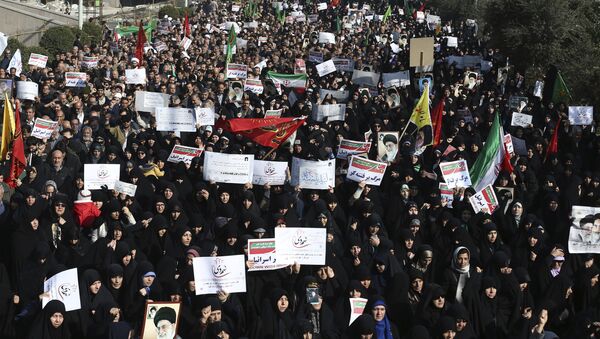The extent of anti-government sentiment in Iran has been blown out of proportion, with many media outlets, politicians and global activists clearly exaggerating the scale of the protests, in a bid to escalate the ongoing crisis.
On social media platforms, users have been posting apparent footage and images of protests from Iran, but, in several cases, the material is from completely unrelated protests in other countries.
Tens of thousands all over Iran and Kurdistan are rising up against the Iranian regime and is reaching new cities every hour. #Kermanshan #Iran pic.twitter.com/9nSO0m9wcf
— Ranj Al Abadi (@Ranj__Talabany) 29 декабря 2017 г.
The above tweet claims to relay video footage of an anti-Khamenei protest in the city of Kermanshah, but, as identified by other users on social media, the video is actually of an anti-government protest in Buenos Aires, Argentina.
Whoa! 300,000 March for democracy in Iran! Incredible! #IranProtest #SundayMorning #HappyNewYear pic.twitter.com/BQZuXDbh11
— Kambree Kawahine Koa (@KamVTV) 31 декабря 2017 г.
This tweet, posted by an avid Trump supporter, claims to show "300,000 people marching for democracy in Iran." However, the footage is from a protest in Bahrain in 2011, with the protestors chanting in Arabic, and waving Bahraini flags. It should also be noted that the current protests in Iran aren't calling for democracy, as Iran is undisputedly one of the most democratic countries in the Middle East.
Ken Roth also shares a pic from a pro-Khamenei rally and suggest it's an anti-Khamenei rally even though it's pretty obvious.. pic.twitter.com/RuhCF9AdhG
— Lina Arabi (@LinaArabii) 31 декабря 2017 г.
Perhaps more embarrassingly, there have also been cases of users attempting to depict pro-government rallies as anti-Khamenei protests. Executive Director of Human Rights Watch (HRW) Kenneth Roth recently posted an image of an alleged anti-Khamenei protest. In actuality, the image was of a recent pro-Khamenei rally.
Such pro-government rallies — which have taken place in over 1,200 cities and towns across Iran — have received very little media coverage, similar to how pro-Assad rallies were completely ignored by most media outlets in the infant weeks and months of the Syria crisis.
READ MORE: 'Finish Line'? Trump 'to Fix or Cancel' Iran Nuke Deal Next Week — Tillerson
Much of the recent anti-Iran propaganda is being peddled by Trump supporters, Saudi Arabia, and Kurdish media outlets. All of the aforementioned groups are keen to see an unstable, war-torn and weakened Iran, as it would directly serve their interests.
Donald Trump, his supporters and, to a lesser extent, the wider US, are hostile to the current Iranian government, with bilateral relations remaining frosty since 1979, after the Islamic Revolution resulted in the removal of US puppet Mohammad Reza Pahlavi.
Iranian Kurdish separatists — primarily from the PJAK militant group — have fought an insurgency against Iran for years, so they are inciting instability and unrest to potentially capitalize on further escalation, as their Syrian counterparts did in northern Syria.
READ MORE: 'Iran Does Not Bow: This is Its Real Crime in the Eyes of Western Ideologues'
Unsurprisingly, Saudi Arabia has also been cheering on the recent riots, as Iran played an instrumental role in defeating Daesh (ISIS/ISIL) and other Saudi-backed terrorist groups in both Syria and Iraq, bringing Saudi Arabia's plans for regional dominance to an abrupt end.
Iranian President Hassan Rouhani has vowed to improve the economic situation in the country, and criticized Saudi Arabia and the US for attempting to destabilize Iran. He also said that Iranians are allowed to protest against the government, but added that violence is unacceptable.
"Iranians are completely free to express their criticism of the government or stage protests, in a way that would lead to the improvement of the country's conditions," President Rouhani said.
The views expressed in this article are solely those of the author and do not necessarily reflect the official position of Sputnik.

